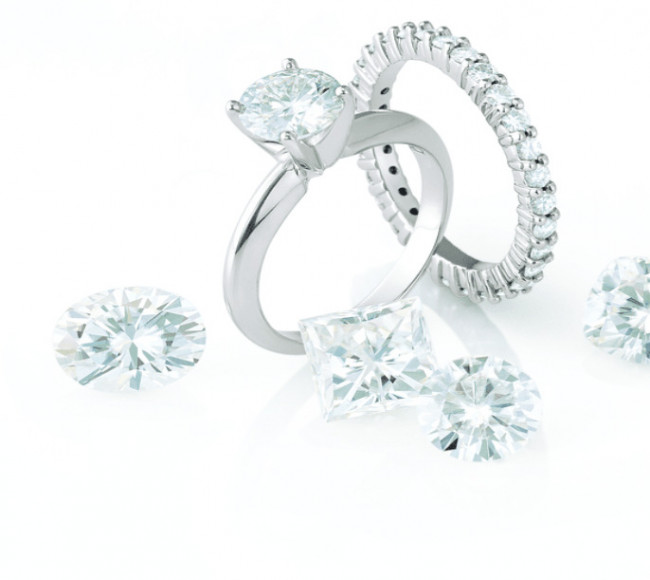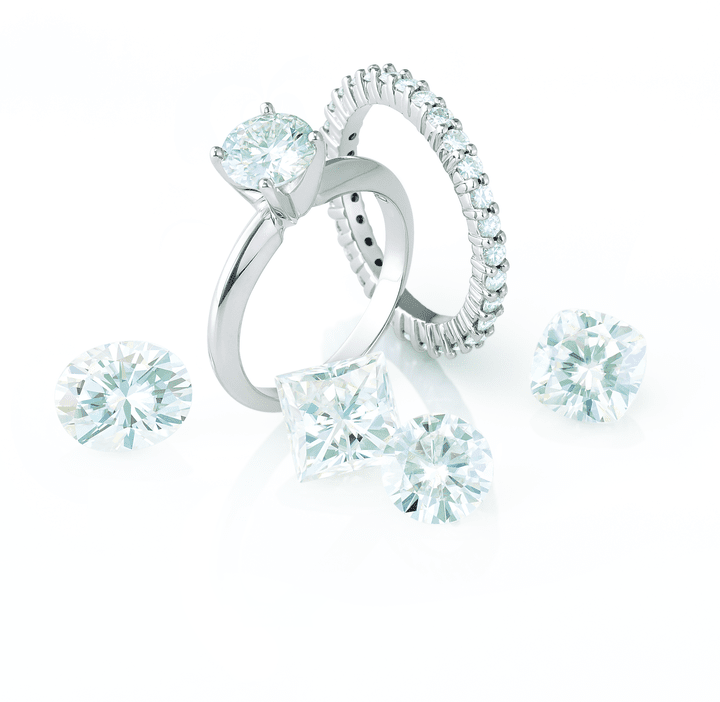
Table of Contents

A Girl’s Best Friends — Moissanite vs. Diamond?
The Moissanite vs. Diamond debate is interesting when comparing costs and the value of both stones, for they are both beautiful jewels in their own right.
Marilyn Monroe famously declared, “Diamonds are a girl’s best friend.” Millions still agree with her statement. While nothing sparkles exactly like a diamond, Marilyn passed away before the advent of laboratory-produced moissanite (named after Nobel-prize-winning Scientist Henri Moissan).
What are moissanites, and how do they compare to diamonds in appearance, value, and durability? In order to compare these two hard rocks, we have to look at the differences between Moissanite vs diamond and find out what makes them similar or different from each other.
What is Moissanite?
Moissanite belongs to the silicon carbide group of minerals. Moissanite looks similar to diamonds at first glance but can be distinguished from diamonds with a ten times magnification lens. If you look at the stone under a microscope, you will notice that moissanite has many internal characteristics, making it unique and easily distinguishable from diamonds.
What is Diamond?
A diamond can be defined as a pure crystallized carbon with the geometrical shape of a regular octahedron. Though diamonds do occur naturally, nowadays, people are often skeptical about buying them due to the high level of lab-created diamonds, as is the case with moissanite.
Diamonds are forever established as one of the most popular gemstones in history, though their popularity has been relegated by the rising awareness of moissanite VS diamond among consumers.
Where does natural Moissanite come from?
In 1893, Nobel-prize-winning scientist Henri Moissan discovered these beautiful gems in an ancient meteor crater located in Arizona. Due to their appearance and hardness, Moissan mistakenly believed a natural moissanite was a diamond created by the heat and impact of the meteor! How romantic is that?? Gemstones that were created from the heavens!
However, in 1904, Moissan identified these beautiful gems as approximately 70% Silicon and 30 % Carbon, while diamonds are almost entirely made up of Carbon. In the late 1990s, moissanites began being produced in laboratories. You may be pleasantly surprised to discover that moissanites do well in appearance, value, and durability compared to diamonds.
How is Moissanite Created in a lab?
The man-made industrial process allows for large industrial quantities of Moissanite to be produced through high-pressure, high-temperature (HPHT) processing.
Scientists create moissanite in a lab setting by taking small silicon carbide crystals and placing them inside a chamber containing a carbon-oxygen torch. This torch burns at temperatures of 4,500 degrees Celsius which emits carbon dioxide and methanol gases to form the gems. It takes approximately two to three months to produce a single stone.
Can Moissanite stone be considered a diamond?
In some cases, moissanites are not considered identical to diamonds. Both gemstones have very different properties from substance to brightness and color. Diamonds are naturally discovered and are made from the toughest materials; the diamond has incredible beauty and value. Moissanite is usually fabricated in laboratories using silicon carbides.
They offer many visual differences compared primarily to the diamond in terms of color and light performance and sensitivity to light. Although both Diamond and Moissanite may appear quite similar to one another from afar, they are clearly different in their characteristics.
Diamond vs. Moissanite: Color
Moissanite is usually colorless but sometimes can appear yellow or greyish under different temperatures. Moissanite’s chromium impurities, which are also present in natural diamonds, contribute to its greenish tint. The properties of moissanites allow them to be heat treated and color enhanced in order to bring out their best features.
On the other hand, Diamonds can come in a wide range of colors. This is due to the presence of chemical impurities such as nitrogen and boron. Diamonds are either completely colorless or have very faint traces of yellow, brown, blue, green, pink, or purple hues. Because diamonds are naturally colorless, the colors they display are so light that the naked eye can’t see them.
Diamond vs. Moissanite: Brilliance and Sparkle
Professionals grade a diamonds score on the 4 Cs—cut, clarity, color, and carat. Read more about the 4 Cs in this post. Moissanites are graded on color and clarity, and Charles and Colvard and generic brands come in a wide range of colors and clarities, just like diamonds. Moissanites and diamonds have a different kind of brilliance. Diamonds reflect light in three different ways, making them the king of sparkle.
Moissanites have a different facet pattern than diamonds, and because of this, they emit rainbow flashes in sunlight. The bigger the gemstone, the more noticeable these rainbow flashes are. Some love the look of the sparkle moissanite emits, but others dislike the colored flashes of light.
The different type of sparkle is what sets these two stones apart. If you are looking for a classic and incomparable sparkle, a diamond will be your best friend. If you are looking for an excellent, budget-friendly diamond alternative with its own signature sparkle, moissanite is right for you! Some have concerns about choosing a large moissanite center stone because of possible appearance issues. Still, we at Bling Advisor would love to help you design a custom-designed piece that uses both moissanites and diamonds so that you can have a look you love and stay on budget!
Moissanite vs Diamond: Durability
Are moissanites as durable as diamonds? Not quite. On the Mohs Scale, only Diamonds are the hardest known mineral scoring a 10 for hardness. Moissanites score 9.25 using the same scale. Both can confidently be worn daily. Because diamonds are harder than moissanites, diamonds could scratch your moissanites or any other gems that may be considerably lower on the Mohs scale—store both your diamonds and moissanite separately from other gemstones, so they do not scratch them.
Diamond versus Moissanite: Clarity
Most moissanite sold is graded for clarity using similar measures as the GIA and other grades in determining diamond clarity. Generally, the clarity for moissanite describes the amount (if any) of the blemish in the stone. Like diamonds, moissanite tends to be imperfect, meaning there are typically minor imperfections visible if viewed in greater detail.
Some diamonds are very clear, some contain flaws, and some have carbon spots. Moissanite contains fewer carbon spots than diamonds. Diamonds may or may not contain many inclusions (flaws), whereas moissanites will always have flaws due to the manufacturing process involved.
Diamond vs. Moissanite: Cut and Shape
Moissanite cuts are nearly flawless. They are cut by hand to ensure that the proportions, angles, and depth are perfect. They can be cut into different shapes such as round, cushion cut, pear shape, and more. Note that the diamond shape does affect its price.
On the other hand, many diamonds have flaws in their cutting process. These imperfections can look like dark areas once set, called ‘inclusions’ or ‘carbon spots’ Diamonds with more minor inclusions are less visible to the naked eye, but they still have flaws.
Diamond vs. Moissanite: Cost
Because moissanites are created in a laboratory, they offer significant savings compared to diamonds occurring in nature that must be mined. They also do not have the same ecological or humanitarian impacts many are concerned with. Diamonds sourced by Bling Advisor go through strict industry standards to ensure they are conflict-free. Diamonds can also be lab-created to ensure that they are sourced ethically, environmentally friendly, and offer savings compared to a natural diamond.
What is Forever Brilliant Moissanite?
Forever Brilliant moissanites are created by Charles and Colvard. These stones are specially treated to give them the maximum brilliance available in a lab-created stone. When held up to the light, they sparkle with rainbow fire just like an expensive natural diamond. This beautiful color is achieved using careful control of the treatment process. The brilliant surface reflection is what sets these moissanites apart. They are the only available moissanite that has this rainbow fire color definition, similar to a natural diamond (although no gemstone can compare to diamonds.
What is Forever One Moissanite?
Forever One moissanites are also created by Charles and Colvard. Forever One provides a range of colors, including blue, green, and yellow, which can be used in jewelry. They look great, set as side stones or center stones on different colored jewels.
Is it worthwhile to buy moissanite?
Moissanites are a great alternative to diamonds. They’re available in different colors and offer the same brilliance like diamonds. According to experts, moissanite rings appear more brilliant than diamonds. They are also available in different shapes and sizes to suit all your needs.
Moissanite jewelry
Moissanites jewelry is an affordable way to get stunning jewelry without paying a small fortune. According to your preferences, moissanite earrings, rings, and necklaces are available in different shapes and sizes.
Nowadays, many jewelers offer moissanite gems as a realistic alternative to diamonds. If you’re tired of breaking the bank to buy stunning jewels, try moissanites or other lab-created stones.
Moissanite engagement ring
A Moissanite engagement ring look real, and most importantly, this stone is affordable. You can get stunning a moissanite engagement ring from the comfort of your home without any hustle. Many find this option ideal as it is both affordable and looks great.
Moissanite engagement rings maintenance
Now and then, follow this fine jewelry care guide and clean your engagement ring to keep it sparkling. A Moissanite engagement ring is as precious as a diamond one, so you must take extra care of it.
A moissanite stone has a Mohs hardness rating of 9.25 – slightly softer than a real diamond at 10. This means that they can be chipped or scratched just like natural diamonds.
You can clean your moissanite engagement ring with warm water and a mild soap without using harsh chemicals or solutions that may damage its surface. This is why it is recommended to remove your ring before undertaking any hard work at home, cooking, cleaning the house, etc.
Diamond Alternatives
A moissanite stone is often viewed as a cost-effective alternative to buying a diamond. If you want to purchase an engagement ring but aren’t totally sold on a diamond, you might want to keep the following diamond simulant in mind:
– moissanite and lab created diamonds
– gemstones such as rubies, sapphires, and morganites
– Diamond alternatives like cubic zirconia
Moissanites vs Diamonds: The Conclusion
Moissanites and natural diamonds are nearly identical in appearance to the average person. Both are two of the hardest gemstones man has discovered, have timeless elegance and brilliance, last for generations, and are excellent for daily wear. Which one is right for you or your loved one? That totally depends on personal choice.
If you have social or environmental concerns regarding naturally mined diamonds or would like a stone comparable to the beauty of a diamond with less cost, moissanites are a stunning option. If you are more of a traditionalist with less budget restriction and are looking for timeless, prestigious stones, diamonds will not disappoint. Diamonds and moissanites are a girl’s best friends!
With Bling Advisor you can always custom design your jewelry pieces; we are here to help!
